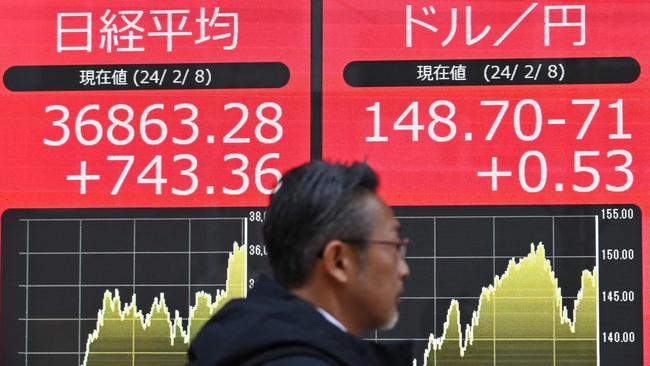Soft landing likely for US, developed markets
Despite conflict in the Middle East and Ukraine, the drivers of last week’s sharemarket sell-off are based on economics and earnings, not geopolitics.

The past two weeks has seen a sell-off in sharemarkets globally. The Nasdaq 100 reached a technical correction, down more than 10 per cent from its peak. The Tokyo Stock Price Index (Topix) also reached technical correction levels. The ASX was not immune, falling almost 6 per cent.
Profit taking was particularly intense in highly valued, high price-to-earnings multiple (PE) sectors such as technology. Quality bonds performed well due to a flight to safety. The Australian dollar, which is seen as leveraged to global growth, depreciated.
There are a number of reasons for this. Certainly, geopolitics is in an unpredictable situation to say the least, with war in the Middle East, war in Ukraine and an upcoming US election. However, the drivers behind the sell-off are based on economics and earnings, not geopolitics.
Fears of a recession have increased in the US. US labour data has been noticeably weak, with July unemployment increasing to 4.3 per cent from 4.1 per cent. Purchasing Managers Index (PMI) composites – closely followed measures of economic activity – have retreated in the US, Europe and China.
Earnings reports from the US mega capitalisation tech stocks were a little disappointing in terms of the growth created by artificial intelligence (AI) spending. This saw profit taking. Finally, we have also seen the Bank of Japan raise rates by 0.15 percentage points to 0.25 per cent.
This may not seem significant, but in the context of Japan, it was enough to send the yen sharply higher. This caused the unwind of the yen carry trade (using low-interest yen-based loans to pay for sharemarket investments). Investors are selling investments such as US technology and ASX stocks in order to repay yen loans, which are suddenly much larger in US dollars. It also results in locals, who are often active overseas investors, selling the Nikkei as they seek liquidity to repay margin loans.
These latest data points have not changed our view on markets. It can be a mistake to read too much into a single data release. The weakness of the July jobs report was probably accentuated by Hurricane Beryl. The number of people who reported being unable to work due to the weather was 436,000; this compares to an average of 33,000 for July since 2000. In addition, the rise in unemployment partly reflected an increase in the number of Americans seeking jobs.
For investors, we see this as an overdue tactical correction rather than a sustained unwinding to sell. The backdrop remains conducive, in our view, supported by a US economy that’s still headed for a soft landing rather than a recession. The unemployment rate remains low by historical standards, there are few glaring imbalances, and most importantly, the Fed has plenty of scope to quickly cut interest rates to reinvigorate growth.
That’s exactly what we think policymakers will do – we now expect 100 bps of rate cuts by year end (versus 50 bps previously). Importantly, inflation is also closing in on the Fed’s 2 per cent target, the boom in AI capital investments is likely to endure, and profits are healthy. S&P500 earnings are on track to grow 10 to 12 per cent for the June quarter.
We see the sell-off in AI-related stocks as an opportunity. Although the market is grappling with how much value to attribute to AI, just like it did with the internet in the early days of application development, investment in AI is a long-term trend.
Second-quarter big-tech guidance on AI monetisation has been mixed, but we agree with Alphabet CEO Sundar Pichai’s assessment that “the risk of underinvesting is dramatically greater than the risk of overinvesting”
Right now, we are suggesting that clients target the “enabling layer” of the AI value chain. Sometimes called the “picks and shovels” of AI, the enabling layer is the infrastructure that enables the massive computing power required for AI. It includes data centres, the servers that go into data centres, the chips that go into the servers and the electrical infrastructure that delivers power to the data centres and cools them. It also includes the cloud services that connect the enabling layer to the data and application tools of AI. This favours semiconductor giants and certain vertically integrated mega tech stocks.
Corrections in sharemarkets are not unusual. Twenty-three of the past 44 years saw the S&P 500 correct 10 per cent or more during the year. This sort of weakness can last for some months. The important thing is not to be impacted by recency bias – overemphasising recent events – when considering investment decisions.
Our base case remains a soft landing for the US and other developed markets. We have been buyers of quality Australian dollar bonds and remain so. Although yields have fallen, A-rated Australian corporates are still paying over 5 per cent for five years’ duration, which is historically attractive.
We have been recommending clients keep some powder dry for equity buying, but to use some of that powder now to build exposure to AI stocks.
Andrew McAuley is managing director at UBS Global Wealth Management Australia.



To join the conversation, please log in. Don't have an account? Register
Join the conversation, you are commenting as Logout